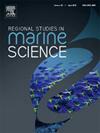An effective way to monitor the population of juvenile horseshoe crabs in the Beibu Gulf of China
IF 2.1
4区 环境科学与生态学
Q3 ECOLOGY
引用次数: 0
Abstract
Population conservation of horseshoe crab is urgently required in China as their population is declining dramatically. However, conservation efforts are severely constrained by the lack of information on the population dynamics of the species. Here, a citizen science-based investigation was conducted to continuously monitor the population dynamics of juvenile Tachypleus tridentatus and Carcinoscorpius rotundicauda in the Beibu Gulf of China over five years. A low abundance of horseshoe crabs was observed at all stations. T. tridentatus was primarily observed in the eastern of Beibu Gulf, with an abundance (0.179 ind/100 m2) larger than that of C. rotundicauda (0.007 ind/100 m2). The prosomal width range of T. tridentatus was between 9.0 and 138.0 mm while that of C. rotundicauda was between 20.0 and 111.0 mm, representing their different age distribution patterns. A continuous distribution pattern from 3rd to 14th instar was observed in the T. tridentatus population, whereas a discontinuous distribution pattern from 6th to 16th instars was observed in the C. rotundicauda population. This instar distribution pattern implies that these areas are crucial nursery habitats for the two species. No horseshoe crab within the 1st to 2nd instars (for T. tridentatus) or before 6th instar (for C. rotundicauda) were observed within five years, indicating a declining age structure with few natural births. It was concluded that the declining population would exacerbate the risk of endangered horseshoe crab. There is an urgent need to strengthen the protection of horseshoe crab in the Beibu Gulf, particularly to protect their nursery habitats. The value of long-term citizen science based-monitoring was highlighted, which greatly increased public awareness of horseshoe crab protection.
监测北部湾鲎幼体数量的有效方法
由于鲎的数量正在急剧下降,中国迫切需要对其进行种群保护。然而,由于缺乏有关该物种种群动态的信息,保护工作受到严重制约。在此,我们开展了一项以公民科学为基础的调查,对中国北部湾的三疣梭子蟹(Tachypleus tridentatus)和胭脂鱼(Carcinoscorpius rotundicauda)幼体的种群动态进行了为期五年的连续监测。在所有站点都观察到了低丰度的鲎。三疣梭子蟹主要分布在北部湾东部,其丰度(0.179 ind/100 m2)大于轮纹梭子蟹(0.007 ind/100 m2)。三疣梭子蟹的前体宽范围在 9.0 至 138.0 mm 之间,而罗纹梭子蟹的前体宽范围在 20.0 至 111.0 mm 之间,代表了它们不同的年龄分布模式。三疣梭子蟹种群从第3龄到第14龄呈连续分布,而罗纹梭子蟹种群从第6龄到第16龄呈不连续分布。这种幼体分布模式意味着这些区域是这两个物种的重要育幼栖息地。在 5 年内,没有观察到第 1 至第 2 个态期的鲎(T. tridentatus)或第 6 个态期之前的鲎(C. rotundicauda),这表明鲎的年龄结构在下降,自然出生的鲎数量很少。结论是,种群数量下降将加剧濒危鲎的风险。因此,迫切需要加强对北部湾鲎的保护,尤其是保护它们的育幼栖息地。会议强调了基于公民科学的长期监测的价值,这极大地提高了公众保护鲎的意识。
本文章由计算机程序翻译,如有差异,请以英文原文为准。
求助全文
约1分钟内获得全文
求助全文
来源期刊

Regional Studies in Marine Science
Agricultural and Biological Sciences-Ecology, Evolution, Behavior and Systematics
CiteScore
3.90
自引率
4.80%
发文量
336
审稿时长
69 days
期刊介绍:
REGIONAL STUDIES IN MARINE SCIENCE will publish scientifically sound papers on regional aspects of maritime and marine resources in estuaries, coastal zones, continental shelf, the seas and oceans.
 求助内容:
求助内容: 应助结果提醒方式:
应助结果提醒方式:


